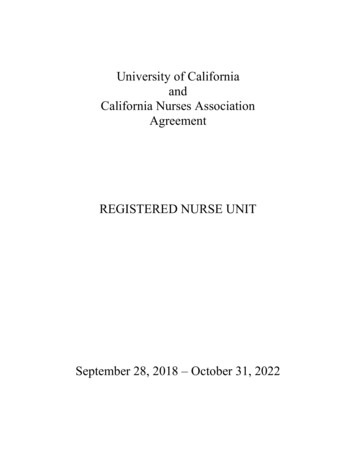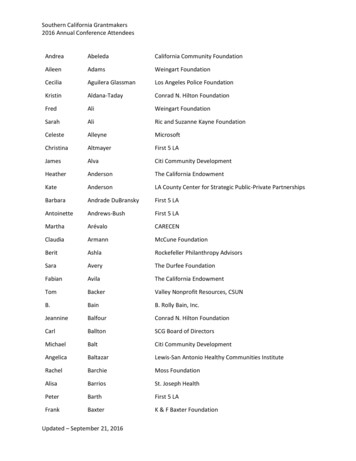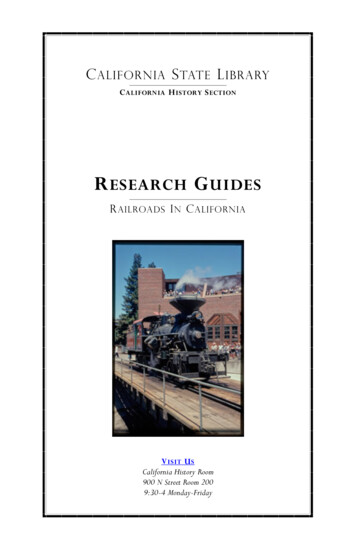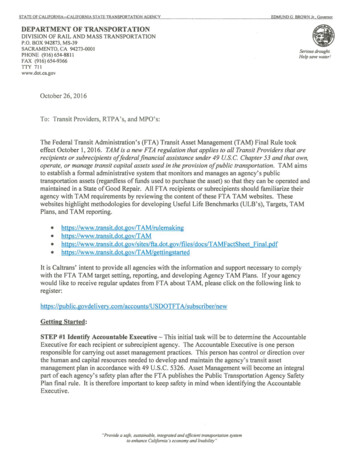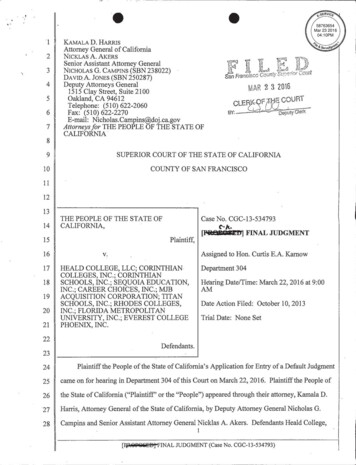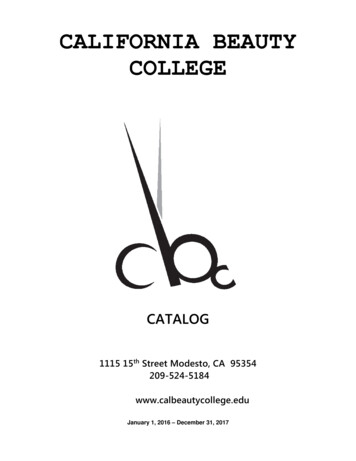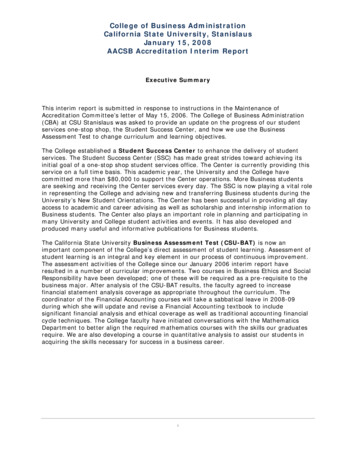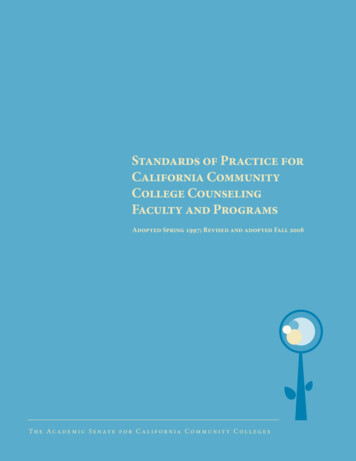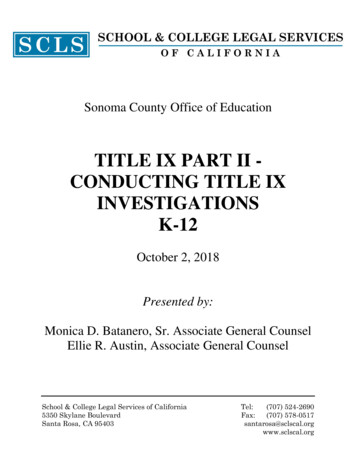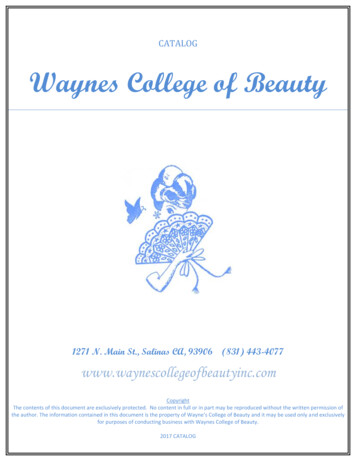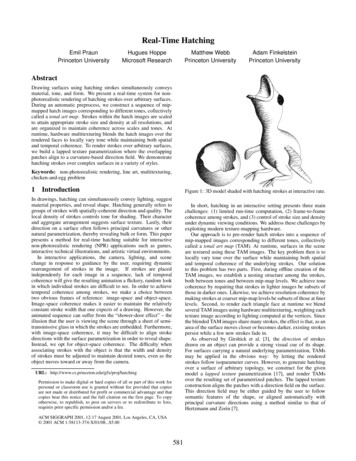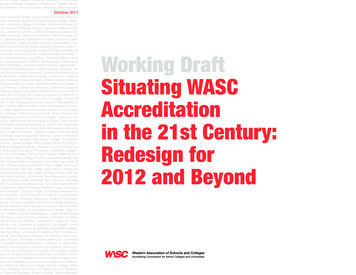
Transcription
emy for Jewish Religion California Academy of Art University Alliantational University American Conservatory Theater American Filmute American Jewish University American University of ArmeniaOctober 2011enter College of Design Azusa Pacific University Biola Universitydman University Brigham Young University-Hawaii California Baptistrsity California College of the Arts California Institute of the Artsrnia Institute of Integral Studies California Institute of Technologyrnia Lutheran University California Maritime AcademyCaliforniastate University California Polytechnic State University, San Luispo California State Polytechnic University, Pomona California Statersity System California State University, Bakersfield California Statersity, Channel Islands California State University, Chico CaliforniaUniversity, Dominguez Hills California State University, East Bayrnia State University, Fresno California State University, Fullertonrnia State University, Long Beach California State University, Loses California State University, Monterey Bay California Statersity, Northridge California State University, Sacramento CaliforniaUniversity, San Bernardino California State University, San Marcosrnia State University, Stanislaus Cedars-Sinai Medical CenterS University Chaminade University of Honolulu Chapmanrsity Charles R. Drew University of Medicine and Sciencemont Graduate University Claremont McKenna College Claremontol of Theology Claremont University Consortium Cogswellechnical College Concordia University Irvine Dominican School ofsophy and Theology Dominican University of California Fieldinguate University Franciscan School of Theology Fresno Pacificrsity Fuller Theological Seminary Golden Gate Baptist Theologicalnary Golden Gate University Graduate Theological Union HarveyCollege Hawaii Pacific University Hebrew Union College-Jewishute of Religion Holy Names University Hope International Universityboldt State University Humphreys College Institute of Transpersonalhology International Technological University Irell & Manellauate School of Biological Sciences John F. Kennedy University Johnhe Great Catholic University Keck Graduate Institute of Applied Lifeces La Sierra University Laguna College of Art and Design Lifec College Logos Evangelical Seminary Loma Linda Universitya Marymount University Marymount College The Master’s Collegeeminary Menlo College Mills College Mount St. Mary’s CollegeNational Hispanic University National University Naval Postgraduateol Notre Dame de Namur University Occidental College Otisge of Art and Design Pacific Oaks College Pacific School ofon Pacific Union College Pacifica Graduate Institute Palo Altorsity Pardee RAND Graduate School Patten University Pepperdinersity Phillips Graduate Institute Pitzer College Point Lomaene University Pomona College Saint Mary’s College of Californiael Merritt University San Diego Christian College San Diego Statersity San Francisco Art Institute San Francisco Conservatory ofc San Francisco State University San Francisco Theologicalnary San Joaquin College of Law San Jose State Universityrd-Burnham Medical Research Institute Santa Clara Universityook University Scripps College The Scripps Research Instituteson University Soka University of America Sonoma State Universityern California College of Optometry Southern California Institute ofecture Southern California University of Health Sciences St. John’snary St. Patrick’s Seminary and University Stanford Universityas Aquinas College Touro College Los Angeles Touro Universityrnia Trident University International United States Internationalrsity Kenya United States University University of California Systemrsity of California, Berkeley University of California, Davis Universityifornia, Irvine University of California, Los Angeles University ofrnia, Merced University of California, RiversideUniversity ofrnia, San Diego University of California, San Francisco Universityifornia, Santa Barbara University of California, Santa Cruzrsity of Guam University of Hawaii, West Oahu University of Hawaiio University of Hawaii at Manoa University of Hawaii Maui Collegersity of Hawaii System University of La Verne University of thec University of Redlands University of San Diego University of Sanisco University of Southern California University of the Westuard University of Southern California Western State Universityge of Law Western University of Health Sciences Westminsternary California Westmont College Whittier College William Jessuprsity Woodbury University The Wright Institute Academy for Jewishon California Academy of Art University Alliant InternationalWorking DraftSituating WASCAccreditationin the 21st Century:Redesign for2012 and BeyondWestern Association of Schools and CollegesAccrediting Commission for Senior Colleges and Universities
A Web of Values and ConcernsWASC’s Role in an Ecosytem
Working DraftSituating WASC Accreditation in the 21st Century:Redesign for 2012 and BeyondWestern Association of Schools and CollegesAccrediting Commission for Senior Colleges and Universities
PrefaceA hallmark of US higher education in the 21st century is theenormous diversity of its institutions and missions, ranging fromflagship public universities serving 50,000 or more students, toprivate, church affiliated academies enrolling fewer than 100.Within this remarkable diversity, however, exists a widespreadunderstanding that across the full reach of its many forms andactivities American higher education represents both a publicgood and a private benefit. This understanding sees highereducation both fostering individual development and betterment and serving the larger needs of our society and nation.In particular, higher education has created the conditions andpossibilities for improving quality of life, solving problems,and enabling hope, including providing a skilled work force andengaged citizenry. Both are essential to supporting economicprosperity and sustaining American democracy.Higher education accreditation today has grown out of this sharedengagement with both its public and private aspects. Within theAmerican context accreditation is a voluntary activity, undertakenthrough negotiated understandings between the institutions themselves and government, and engaged in and supported by theseinstitutions through regional associations. Overall, accreditationhas been committed to creating and assuring standards of performance and dedicated to the realization that ensuring quality,irrespective of the different purposes of individual institutions,was in itself a contribution to the public good.Higher education accreditation has changed in form and substance as it has adapted to continuous changes in the nature ofAmerican society and its population, the effects of increased globalinterdependence, and dramatic developments in informationand communication technology. Increasingly, higher educationaccreditation has been charged by its various constituencies—4students, families, businesses, higher education institutions themselves, the non-profit sector, and government—to assure thequality of the higher education sector amidst these and manyother changes and influences on our landscape. The revision ofthe WASC process described in this document occurs within thecontext of these and other factors and the responsibility to ensureprocesses and outcomes of high clarity and integrity that detail anddocument how quality is achieved, maintained, and improved.Students and their success stand at the center of the concerns forhigher education accreditation. Today the many processes thatmake up accreditation seek to establish standards and measurements for quality that assure that the degrees earned by studentsare achieved in a timely manner and have demonstrable meaningand currency within the society at large including, but not limitedto, the ability of students to experience both meaningful employment within a rapidly changing economy and to achieve viablepathways to civic engagement. Of increasing importance is theability of higher education institutions in our society to recognizeand provide relevant learning for the continuously changingdemands of the 21st century. No less than the future health andshape of American society depend in very large measure on ourability to achieve these outcomes.Perhaps as never before and certainly stimulated by these accelerated levels of change occurring in society, higher educationaccreditation is being asked to move beyond what has been itsprimary and focused activities over the past few decades. Elementsin the current governmental and economic environment, mostespecially the fact that the federal government currently hasexpended and guaranteed over 150 billion in student loan andsupport monies, have both broadened the quasi-regulatoryfunctions that accreditation has come to play within the highereducation sector, and extended its reach even farther into issuessuch as how students move through the process, their costs ofdoing so, and the relative success rates that characterize suchmovement. These concerns, commonly framed as matters ofW ORKING D RA FT / S ITUATING WA S C A CCR E DITATIO N I N T H E 2 1 ST C EN T U RY: R ED ESI G N F O R 2 0 1 2 AN D B EYO N D
accountability and transparency in higher education accreditation,have become central to how the overall processes of accreditationare conceived and carried out. The document that follows seeksto continue our decade long work in focusing on student learningand outcomes and speaks clearly and directly to these issues ofaccountability and transparency in the name of and in pursuitof the values and outcomes detailed above. Rapid growth of online programs/institutions Practices and growth of the for-profit industry Shrinking support for publics and a trend to privatizepublic universities Increased federal regulation Changing demographics, including older, working,more diverse students Swirl: The majority of students attend more than one institution Assuring quality around the emergence of open sourceand Do-It-YourselfersThe Changing Contextfor AccreditationThe 2001 WASC Handbook of Accreditation and Standards plus therevised accreditation process put the entire WASC region on ajourney towards focusing more heavily on educational effectiveness that increasingly became defined by the region’s commitment to learning outcomes and program review. Enormousprogress has been made in those areas during the last decade byall institutions in the region. WASC accreditation has evolvedsince the last comprehensive Handbook Revision in 2001, andthe revision in 2008. The swiftly changing social, economic,environmental, and political landscape has altered the way inwhich higher education is conceived and delivered. The region isnow faced with greatly increased expectations for institutionalaccountability and consumer protection, as well as demands forimproved academic standards and student performance (asmeasured by graduation rates). Additionally, new fiscal realitieshave made cost-effectiveness a paramount issue for WASC and itsconstituent institutions.A summary of the challenges for both higher education andaccreditation includes:Coupled with these challenges are the institutional and publicperceptions of accreditation, which includes a lack of understanding of what accreditation is and its value; that accreditationdoes not provide adequate oversight of the for-profit sector; thataccreditation emphasizes process, not results; that accreditationshows inadequate attention to graduation rates and the actualproficiencies of graduates; that the nature of accreditation is onlya binary “pass-fail”; that accreditation lacks transparency aboutprocess and results; that accreditation is cost-, time-, and laborintensive; and that the terms of accreditation are too long.Historically, accreditation has focused on compliance withminimum standards and quality improvement. Increasingly,however, accreditation has been called to evaluate institutionsagainst higher standards of quality assurance and to assure thatdegrees awarded have meaning and value. The following chartsummarizes the changing role of accreditation. Low graduation rates High student debt/high default rates Difficulty in transferring credit Dissatisfaction with quality of undergraduate education/low levels of learningW O R K I N G D R AF T / SI T U AT I N G WASC AC C R ED I TAT I O N I N THE 21ST CE NTURY: R E D E SI G N FOR 2012 AND B E YOND5
The Changing Role of AccreditationCore Functionsof AccreditationCompliance CenteredImprovement CenteredAccountability/Quality Assurance CenteredScope of ReviewAll standards applied toassure complianceKey areas selected andapproved by accreditor forimprovementSpecific areas identified aspart of all reviews to addresscommon policy issues—e.g.,retention/graduation rates,student learning outcomesLevel of JudgmentMust demonstrate standards are met at least atminimum levelSimplified compliance reviewand primary emphasis onrecommended improvementsExternal reference pointsreviewed and evaluated—by comparative indicatorsof institutional typePublic ReportingPublic announcement ofgrant of accreditationReports internally circulatedfor improvement; accreditingaction publicly reportedMeaningful and clear publicinformation about institutionalperformance and commissionactions reportedBackground on theProposed New FrameworkDuring April 2010, a group of Commissioners gathered together atWASC’s Academic Resource Conference (ARC), “ to considerthe kinds of changes that might be needed in WASC’s Standardsand review processes in the next Handbook revision.” Theyrevisited the core values that guided the 2001 Handbook revisionprocess and discussed goals for the process. In the summer of 2010,the Commission invited international and national experts in thefield of higher education (Peter Ewell, Arthur Levine, Kevin Carey,Pat Hutchings, Brice Harris, Graham Leicester and MaureenO’Hara) to prepare papers on the future of regional onceptpapers6In the fall 2010, the WASC staff created a comprehensive planfor the accreditation redesign process, including the establishmentof a widely-representative Steering Committee and Task Forces,whose members represent institutions throughout the region.“Listening Sessions” were launched in October and the SteeringCommittee met in November 2010 for the first time. At thismeeting, the Steering Committee devised a set of goals for theaccreditation redesign that was then accepted by the Commission:1. Shorten and/or focus the institutional review process andcreate multiple, adaptive approaches to review.2. Develop a clear public accountability and quality assurancerole that moves beyond minimum standards.3. Increase transparency in the accreditation process.4. Explore core competencies, graduation proficiencies, and thepossible applications of the Lumina Degree QualificationsProfile (DQP) within the accreditation process.W ORKING D RA FT / S ITUATING WA S C A CCR E DITATIO N I N T H E 2 1 ST C EN T U RY: R ED ESI G N F O R 2 0 1 2 AN D B EYO N D
5. Identify levels of accreditation, moving beyond merely being“accredited” or not.WASC Convened Task Forces6. Bridge senior-level institutions with community collegesmore effectively.7. Clarify what can be taken off the table in the review process,so that institutions with long histories of compliance with ourStandards are not required to demonstrate repeatedly that theymeet minimum thresholds.Levels of Learning/Degree Profile8. Explore alternative models and new approaches to educationand credentialing and the role of WASC in that effort.9. Increase oversight of for-profit institutions, especially thosethat are publicly traded.RetentionandGraduation10. Develop a public advocacy role to communicate about issuesof quality and effectiveness in higher education.PublicReporting andTransparencySteeringCommitteeTask Forces met in January 2011 through August 2011. TheRedesign Process Task Forces were formed around specific areasof exploration and charged to1. Repurpose accreditation to be a robust and visible voice andagent for public accountability and quality assurance,InstitutionalReview Process2. Create a credible, but adaptive evaluation process that meetsfederal obligations, focuses on key issues, and builds on theprevious work of institutions undertaken as part of reviewsunder the 2001/2008 Handbook.ChangingEcology of HigherEducationThe Task Force recommendations were then synthesized by asmall group of leadership into one comprehensive framework.These recommendations were reviewed by the Task Force chairsfor their approval and then given to the Steering Committee fortheir October 2011 meeting. At that meeting, further consolidationand changes were made to respond to both external and internalcalls for reform.The proposed framework is being presented for discussion atregional forums in Southern California on October 13, Hawaiion October 18, and Northern California on October 21. Awebinar will be held on October 26 at 11 a.m. and is open toanyone in the region. In addition, you can provide commentsthrough our website, www.wascsenior.org.W O R K I N G D R AF T / SI T U AT I N G WASC AC C R ED I TAT I O N I N THE 21ST CE NTURY: R E D E SI G N FOR 2012 AND B E YOND7
Gathering Feedback forAccreditation RedesignSources of FeedbackSteeringCommitteeMeetingsEvaluations ofVisits from Teamsand InstitutionsProposedAccreditationRedesignExternal Review(2006–2007)CommissionMeetingsTask ForceMeetingsALO and CAOForumDiscussions at2011 ARC8The Commission conducted its own research and undertook astudy of team reports and team evaluations of institutions underthe Educational Effectiveness Framework. This confirmed thateven with the 2008 Handbook revisions, significant variations andinconsistencies continued to be found in reviews of retention andgraduation, and that after ten years, institutions were still heavilyfocused on the structures and processes of assessment, but hadnot made significant progress in evaluating or benchmarkinglearning results. While there was considerable support for thegoals of the three-stage process as a means to add value andcustomize the accreditation review to each institution, manyinstitutions found the proposal stage to be confusing and thecapacity and effectiveness stages to overlap and not be clearlydelineated. Concern was also expressed about the length of theprocess from proposal preparation to Commission action onreaccreditation and the ability of institutions to sustain the reviewover a period of more than five years.WASC contracted with the National Center for Higher EducationManagement Systems (NCHEMS) to conduct web surveys ofinstitutional Chief Executive Officers (CEO), Chief AcademicOfficers (CAO), and Accreditation Liaison Officers (ALO) inJanuary and February 2011, evaluating both the overall accrediting process and each of the Standards. According to the respondents, the top three challenges facing WASC were pressure tomake accreditation a process that adds value to an institution;pressure to keep accreditation cost-effective; and the transformation of collegiate learning that is occurring through new modesof instructional provision, including distance and asynchronouslearning modalities made possible by new technologies and theapplication of cognitive science to improve learning effectiveness.W ORKING D RA FT / S ITUATING WA S C A CCR E DITATIO N I N T H E 2 1 ST C EN T U RY: R ED ESI G N F O R 2 0 1 2 AN D B EYO N D
WASC also conducted a survey of ALOs at the 2011 ARC. TheALOs encouraged WASC to pay attention to institutionaldifferences and then customize the review; to promote, provideguidance, and facilitate partnerships/collaboration; to role modelbeing the next generation; to define best practices; to ask institutions to make sure their learning outcomes are appropriate for alldegree levels; to provide
University Pardee RAND Graduate School Patten University Pepperdine . accreditation has been charged by its various constituencies— students, families, businesses, higher education institutions them- se
